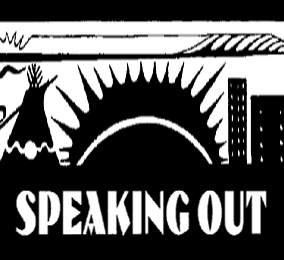by John Copley
(ANNews) – In December 2016, Alberta Human Services formed a 10-person panel to investigate what critics said was government’s failure to properly handle and thoroughly examine the death of four-year-old Serenity, a young brutalized child who died from a brain injury in 2014. The coroner’s office noted that the child’s emaciated body also showed signs that she’d been sexually abused. But the panel’s job goes much deeper than investigating a single case of government bungling and indecision. The child welfare system and the kinship care program are flawed and everyone in the province, particularly the Indigenous population, knows it. Though the Indigenous population in Alberta represents less than six percent of the total head-count, 60 percent of children in care are Indigenous children.
In Serenity’s case the Alberta government has admitted to taking too long to hand documents relating to the four-month-old’s death over to the RCMP. That’s part of the reason why they agreed to set up a panel to further investigate the matter, examine the inner workings of the child welfare system and come up with viable recommendations. But this is neither the province’s nor the child welfare system’s first rodeo; during the past eight years there have been six similar panels set up to examine the same things.
The fact is, Serenity’s case is just one of many that could be opened for further investigation when one considers that the Ministry of Children’s Services recently reported that between April 2014 and December 2016, 73 children and youth receiving child intervention services, died in Alberta.
On January 18, 2017, the province named three experts to the 10-person panel that includes more than a half dozen provincial MLAs and three opposition caucus leaders. Those experts include Patti LaBoucane-Benson, director of research and evaluation at Native Counselling Services of Alberta; Peter Choate, assistant professor of social work at Mount Royal University; and Bruce MacLaurin, a professor of social work at the University of Calgary.
During the last three months, several reports have made their way into the mainstream media and it is becoming more and more obvious that it’s going to be difficult to get a consensus that can bring about positive change. Unless, perhaps, government listens and acknowledges that families and children in care must be included in matters that affect them. That’s the stance taken by many people in the community including LaBoucane-Benson, who told CBC that too often the focus of internal reviews involves talking with their own staff members and to the health care professionals responsible for the care of the children.
LaBoucane-Benson lauded the Office of the Child and Youth Advocate, who along with the Chief Medical Officer and Fatality Review Board, investigates cases that involve children in crisis, including those who have died.
“The only process in this entire thing that I’ve seen that talks to families is the Office of the Child and Youth Advocate,” emphasized LaBoucane-Benson. “The youth advocate (Del Graff) does family interviews and his reports are fantastic.”
“Do the families have any voice in this review?” she questioned, noting that their participation could add a better understanding to each case.
“Asking the family’s perspective on perhaps the nature of the relationship with the service providers and the children in the families might help with the quality control process,” she suggested.
The OCYA generally provides key recommendations at the end of each report but unfortunately his recommendations are often not implemented.
The statutory director of children’s services, Eldon Block, agreed that LaBoucane-Benson had made a good point and one he said the ministry would further look into.
Métis Child and Family Services Executive Director Don Langford said the child welfare system is plagued with problems, some stemming from a lack of finances, others from the complacency of bureaucracy and more from case workers and supervisors who neither understand Indigenous peoples nor include them at the tables where decisions are made.
One local and respected Elder confided that positive change might take place once all Canadians have the opportunity to understand Indigenous culture and history and become a part of the reconciliation process, but suggested, ‘don’t hold your breath.’
“Society has for far too long skirted the edges, taken the short cuts, and come up with a host of imaginary ways to keep Indigenous peoples at arm’s length,” he said. “If the Truth and Reconciliation Commission’s recommendations come to fruition we might get the truth and with that would come a whole new perspective on what Canada’s successive line of governments have done to keep us poor, to keep us uneducated, to keep us on the edge of society. I think a lot of it has to do with the shame that many Canadians feel about what their ancestors did when they first arrived on the shores.
“The child welfare system can work much better than it does, but that’s going to take a great deal of work – only when someone steps to the forefront and ensures the Indigenous leaders, professionals and citizens are not just included, but allowed to be full participants whenever decisions affect them, can positive change take place.”
What is really needed is a set of fresh ideas and perhaps a better educated array of people to look after this important government portfolio. The Aboriginal community is loaded with well informed, educated and practicing professionals and they could play an integral role in helping to develop a child welfare system with a specific focus on cultural understanding and ensuring that Indigenous children placed in care grow to become healthy and successful adults.
“This panel,” noted the Elder, “has a lot of politicians on it and that might be a good thing because without them you have no one to implement the recommendations, but it seems to me that you need to bring some families, some children, some Indigenous people who have experienced child services into the equation. If you don’t then how do you really know what those already in the system are experiencing.”
One of the biggest failures of the system is that too many Indigenous children end up in non-traditional settings, many of which are harsh and unsettled environments from which it can be impossible to escape.
Langford told media that “it’s hard to find Aboriginal families with a spare bedroom or two,” noting that there is often more than one child in a family who needs placement. He said that more funding is needed, as are the additional services that will be prerequisite “to helping ensure that Indigenous people have the help they need to successfully foster children and ensure that their individual needs are met.”
In an April 5 interview with PostMedia, Danielle Larivee, the new Minister of the recently formed Children’s Services Ministry, admitted that so far no one has the answers of how to ensure that there are enough Indigenous families healthy enough and hardy enough to welcome children into their homes.
“I don’t know that we have the answers. I think that’s the challenge,” said Larivee. “We haven’t asked the right questions and we haven’t gone to the people that have the answers. So that’s what this is about, talking to our Indigenous partners: What are the barriers? What is happening? Why aren’t those numbers going up? What resources do you need?”
Hopefully those answers will soon be forthcoming because many of the 3500 kids in foster care and another 2000-plus in kinship care homes need to know that they are safe and that someone is paying attention.




I know it’s largely indigenous that are targeted by CFS but there are hundreds of “white families screaming of the corruption and children kidnapped by CFS. Help us all. Facebook-Preserving Families The Fight Against Alberta Child and Family Services